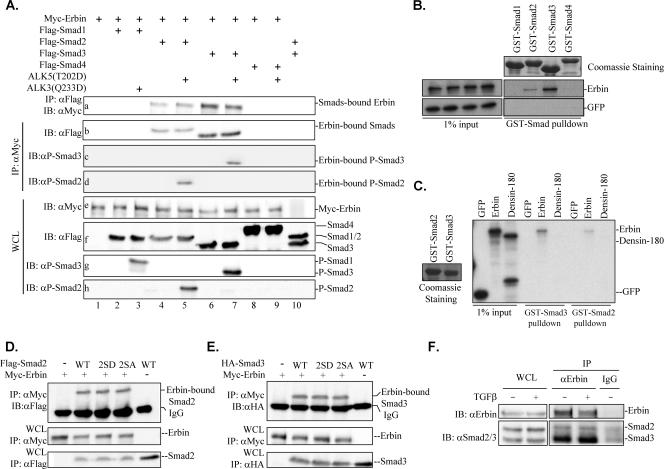FIG. 1.
Erbin associates with Smad2 and Smad3. (A) Erbin interacts with Smad2/Smad3 but not Smad1/Smad4 in vivo. Flag-Smads and Myc-Erbin were cotransfected into HEK293T cells with ALK5(T202D) (lanes 5, 7, and 9) or ALK3(Q233D) (lane 3). The cell lysates were split and immunoprecipitated (IP) with either anti-Myc (αMyc) or anti-FLAG (αFLAG) antibody. Erbin or Smads were detected from immunoprecipitates by Western blotting with appropriate antibodies as indicated. (B) Erbin interacts with Smad2/Smad3 but not Smad1/Smad4 in vitro. In vitro-synthesized Erbin proteins were allowed to interact with GST-Smad proteins on glutathione beads. The GST-Smad-bound Erbin was resolved by SDS-8% PAGE and detected by autoradiography. As inputs, 35S-labeled in vitro-translated Erbin proteins and control GFP (left gels) represent 1% of the total amount of protein used in each interaction assay (right gels). Equal amounts of GST-Smad1 to GST-Smad4 are indicated by Coomassie brilliant blue staining (top right). (C) Smad3 interacts with Erbin but not Densin-180. In vitro-translated Erbin or Densin-180 proteins were allowed to interact with GST-Smad2/GST-Smad3 proteins on glutathione beads. GST-Smad2- and GST-Smad3-bound proteins were resolved by 8% SDS-PAGE and detected by autoradiography. Equal amounts of GST-Smad2 and GST-Smad3 are indicated by Coomassie brilliant blue staining (left). (D and E) Erbin interacts with Smad2/Smad3 mutants. HEK293T cells were transfected with Myc-Erbin and Smad2/Smad3 (wild type or deletion mutants) as indicated, and Erbin-bound Smad2/Smad3 were immunoprecipitated with anti-Myc antibody and analyzed by Western blotting with anti-Flag or anti-HA antibody. (F) Erbin interacts with endogenous Smad2/Smad3. Cell lysates were prepared from 90% confluent HaCaT cells after 1 h of TGFβ treatment. Endogenous Smad2/Smad3 bound to Erbin were immunoprecipitated with anti-Erbin antibody (αErbin) and detected by Western blotting with anti-Smad2 (αSmad2) and anti-Smad3 (αSmad3) antibodies. WCL, whole-cell lysates; ALK5(T202D), constitutively active type I TGFβ receptor mutant; ALK3(Q233D), constitutively active type I BMP receptor mutant; WT, wild type; 2SA, inactive Smad2/Smad3 mutants with C-terminal Ser-to-Ala mutation; 2SD, active Smad2/Smad3 mutants harboring C-terminal phosphorylation-mimetic Ser-to-Asp mutation; IB, immunoblot; IgG, immunoglobulin G.

